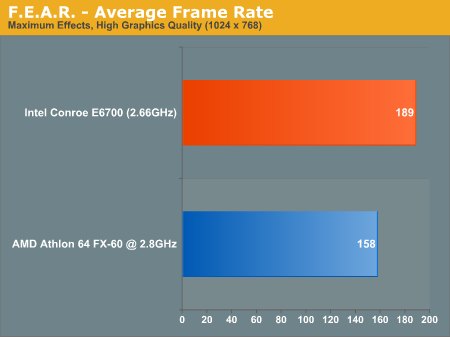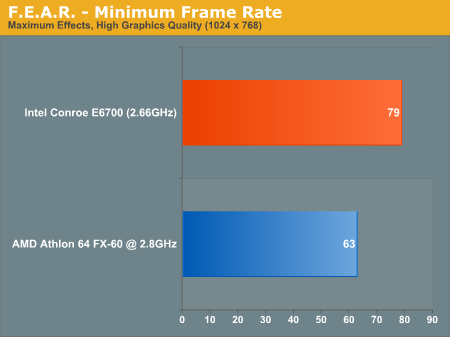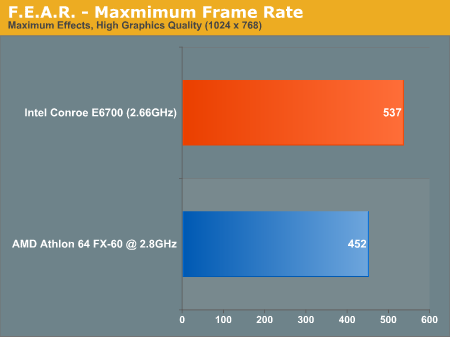Conroe Performance Preview Follow-Up
by Anand Lal Shimpi on March 9, 2006 9:30 AM EST- Posted in
- Trade Shows
The F.E.A.R. Issue
To the readers that pointed out our F.E.A.R. results as being unusually high, we owe you a sincere apology. When we went back to test Conroe for the second time we re-ran all of our tests to make sure that no mistakes were made. We caught the Quake 4 issue where Conroe’s SMP performance was understated, and we also discovered a problem in our F.E.A.R. testing.
While our intention was to test both the AMD and Intel systems at the “Maximum” Computer settings and “High” Graphics settings, only the Conroe system was configured as such. We inadvertently left the AMD system at a higher resolution (1280 x 960) instead of the default resolution (1024 x 768) when you select the “High” Graphics defaults. The oversight was entirely our own doing as Intel was not running the benchmarks or configuring them, it simply happened while we were setting up both systems at the same time. We played with different resolution settings and while deciding that we would go with one, managed to configure the two boxes differently.
Of course this means that our initial F.E.A.R. tests were incorrect, and below we have the correct results with the settings we intended to run both systems on:

The performance advantage of Conroe makes a lot more sense now, at 20% instead of 41%. With performance in Quake 4, UT2004 and HL2 in the 20 - 30% faster range on Conroe, the F.E.A.R. results now make a lot more sense.


To those who pointed out that even the CrossFire X1900 setup would be more GPU bound at 1280 x 960, you were very correct, our original results were inaccurate. We do strive for accuracy and reliability in our results here at AnandTech, which is why we went back and retested/confirmed all of our initial findings before bringing you this update. Aside from the F.E.A.R. and Quake 4 issues that we've since corrected, we found no other performance anomalies in our initial results.










96 Comments
View All Comments
Zebo - Thursday, March 9, 2006 - link
No! read about Osborne effect. Essentially this is why new product demos like this, months ahead of schedule, are so rare and NDAs for all products exist.archcommus - Thursday, March 9, 2006 - link
Well good for Intel for coming out with such a strong product, but I'll always have to go with the best bang for the buck, wonder if that'll still end up being AMD even if their parts are weaker across the board this time around.Just hope AMD stays in the game, we can't afford to have the little guy fall behind too much.
samuraiBX - Thursday, March 9, 2006 - link
I've been a diehard amd fan, but kudos to Intel for ramping up competitive products. I have only a couple of additions I'd like to see with the testing:1. I noticed that anandtech used the 2-2-2-5 T1 timings for the RD480 chipset. I remembered from an anandtech review that the best timings for this chipset is 2-2-2-7; not sure how much of a performance difference that would make, but I'd like to see the difference, however slight.
2. I know that this website's impression of the RD480 chipset wasn't stellar, and while I can understand if Intel couldn't purchase the RD580 chipset two weeks ago, I'd imagine it would have been possible to obtain this week, or at least borrow an RD580 board from ASUS; isn't ASUS a participant at IDF this year?
2. I understand that there was limited time, but I would also like to see how the conroe chip would do with 3d studio max. I'm looking to build a high end 3d animation workstation, and I'm looking at the performance leader, whether AMD or Intel.
Wesley Fink - Thursday, March 9, 2006 - link
We did find 2-2-2-7 to provide the best bandwidth in our memory testing on the RD480 chipset, but the difference between 2-2-2-5 and 2-2-2-7 would be less than 1%, and certainly not significant.samuraiBX - Thursday, March 9, 2006 - link
As an addendum:I went to Bit-tech.net; the performance difference by Conroe is awesome! However, it was curious that on their F.E.A.R. benchmarks, the Intel overclocked FX-60 did worse than the reference FX-60.
Accord99 - Thursday, March 9, 2006 - link
Different platform (NF4), different video card (single OC 7800GT). The bit-tech system may have been mored tweaked and perhaps there's some additional overhead in multi-GPU setups like Crossfire which causes reduced performance at extremely low resolutions.HurleyBird - Thursday, March 9, 2006 - link
Did anyone else notice that on the Intel Quake 4 timedemo performance *increased* for both processors but with Anand's timedemo performance *decreased*I wonder why that is?
IntelUser2000 - Thursday, March 9, 2006 - link
You mean on the SMP enabled and disabled benchmarks?? That's because on the page, while SMP disabled(SMP=0) is first on IDF Quake 4, SMP enabled(SMP=1) is next one while on Anand's Quake 4, SMP enabled is first, while SMP disabled is second(skeptics...).
THANKS FOR CONFUSING PEOPLE ANAND, otherwise great article.
MrKaz - Thursday, March 9, 2006 - link
Why Ati drivers where modified to recognize the Conroe processor?What was the problem if the processor didn’t get recognized?
I mean if the FX60 could say Unknown Processor and have no problems, (my mobile 2600+ says the same and runs OK).
What problem would have come from the drivers by not recognizing the processor?
Some drivers optimizations there? Like NVIDIA/ATI?
amano - Thursday, March 9, 2006 - link
Just wondering.. did they use fear.exe, or a renamed fear.exe?Because there seem to be some issues with the fear benchmarking that cripple the AMD:
http://www.beyond3d.com/forum/showthread.php?t=254...">http://www.beyond3d.com/forum/showthread.php?t=254...